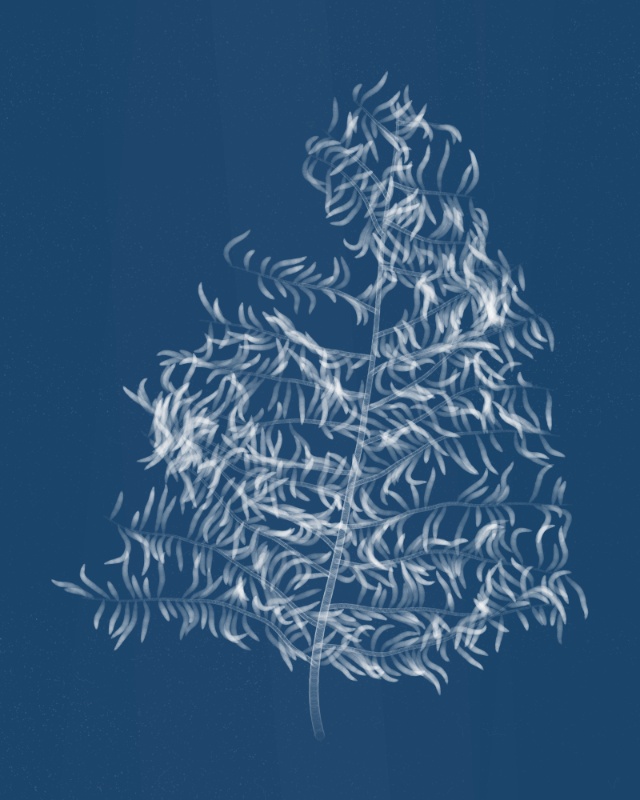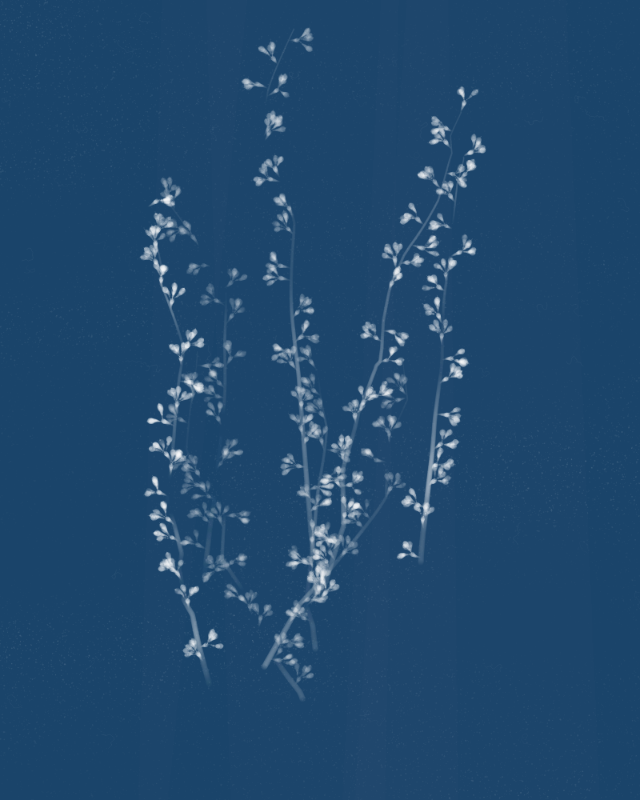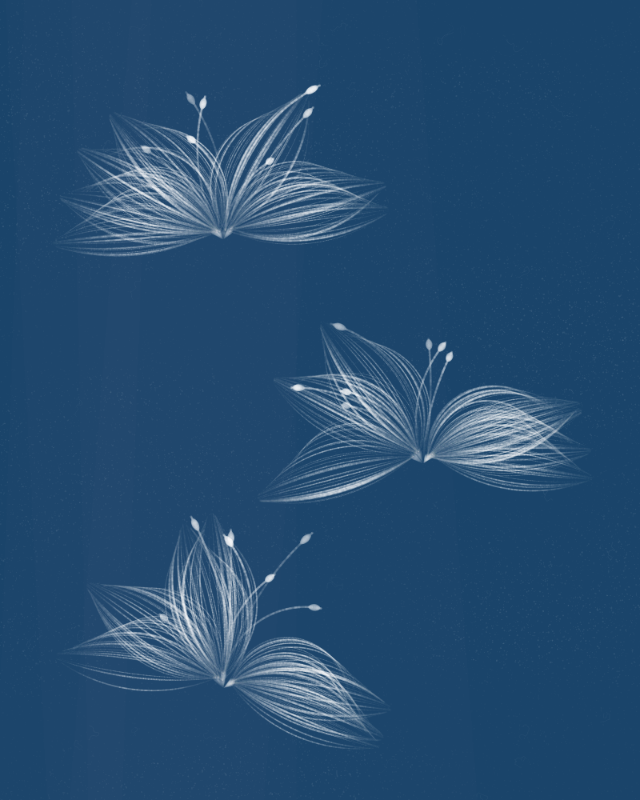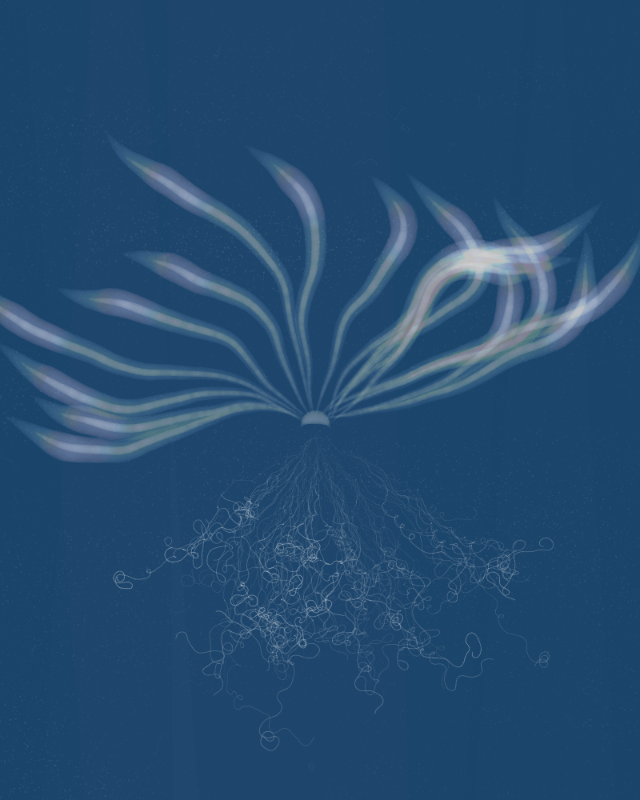Cyanotypes
IPFS

1 August 2022•TEZOS•IPFS
This is an algorithmic tribute to the pioneering work of Anna Atkins (1799-1871). Considered by many the first female photographer, Atkins learned about the cyanotype process soon after it was invented by John Herschel, a family friend. As a botanist, she had the idea of using the new technique to produce contact prints of plants. Her investigations succeeded in capturing the nuances in morphology and the delicate details of many species.
In 1843 she published “British Algae: Cyanotype impressions”, the first published book to use a photographic process for the illustrations. Each copy gathered around 400 prints, each of them individually produced from a different specimen. Thus, all books featured the same species, but each of them was different, in a process that was itself generative in a certain way. Today, about 17 copies of the book are preserved in different institutions. Atkins went on to publish two more books in the following years, with the help of her friend Anne Dixon, dedicated to various ferns and plants.
“Cyanotypes” pays homage to her wonderful work, which sits at the intersection between science and art, and used technology in a novel way to capture the beauty of nature. Here things are taken one step forward, to generate algorithmic simulations of plants, ferns, and algae, which are the work of fantasy and not necessarily faithful to the traits of any real species.
The work features 28 basic configurations, each of them in turn capable of unlimited variations. As was the case with the prints from “British Algae”, every image is at the same time part of a series and unique.
Controls:
[SPACE] to play/pause
[r] to restart the drawing
[f] to toggle fullscreen
[s] to download capture
[2] to [9] to generate and save a hi-res image at multiples of the original 800 x 1000 resolution. Please note that rendering at high resolutions can be very slow.
Made with p5.js.
In 1843 she published “British Algae: Cyanotype impressions”, the first published book to use a photographic process for the illustrations. Each copy gathered around 400 prints, each of them individually produced from a different specimen. Thus, all books featured the same species, but each of them was different, in a process that was itself generative in a certain way. Today, about 17 copies of the book are preserved in different institutions. Atkins went on to publish two more books in the following years, with the help of her friend Anne Dixon, dedicated to various ferns and plants.
“Cyanotypes” pays homage to her wonderful work, which sits at the intersection between science and art, and used technology in a novel way to capture the beauty of nature. Here things are taken one step forward, to generate algorithmic simulations of plants, ferns, and algae, which are the work of fantasy and not necessarily faithful to the traits of any real species.
The work features 28 basic configurations, each of them in turn capable of unlimited variations. As was the case with the prints from “British Algae”, every image is at the same time part of a series and unique.
Controls:
[SPACE] to play/pause
[r] to restart the drawing
[f] to toggle fullscreen
[s] to download capture
[2] to [9] to generate and save a hi-res image at multiples of the original 800 x 1000 resolution. Please note that rendering at high resolutions can be very slow.
Made with p5.js.
Computer code/art/philosophy
> Buenos Aires/Argentina
> TW: @solaas
> IG: @leonardo_solaas
> WWW: solaas.com.ar
280 EDITIONS
•0 RESERVES
minted
280 / 280
dutch auction
6 TEZ
Lorem ipsum project longer longer
0.00001 ETH
Lorem ipsum project longer longer
0.00001 ETH
Lorem ipsum project longer longer
0.00001 ETH
Lorem ipsum project longer longer
0.00001 ETH
Lorem ipsum project longer longer
0.00001 ETH
Lorem ipsum project longer longer
0.00001 ETH
Lorem ipsum project longer longer
0.00001 ETH
Lorem ipsum project longer longer
0.00001 ETH
Lorem ipsum project longer longer
0.00001 ETH
Lorem ipsum project longer longer
0.00001 ETH
Lorem ipsum project longer longer
0.00001 ETH
Lorem ipsum project longer longer
0.00001 ETH
Lorem ipsum project longer longer
0.00001 ETH
Lorem ipsum project longer longer
0.00001 ETH
Lorem ipsum project longer longer
0.00001 ETH
Lorem ipsum project longer longer
0.00001 ETH
Lorem ipsum project longer longer
0.00001 ETH
Lorem ipsum project longer longer
0.00001 ETH
Lorem ipsum project longer longer
0.00001 ETH
Lorem ipsum project longer longer
0.00001 ETH
Lorem ipsum project longer longer
0.00001 ETH
Lorem ipsum project longer longer
0.00001 ETH
Lorem ipsum project longer longer
0.00001 ETH
Lorem ipsum project longer longer
0.00001 ETH























